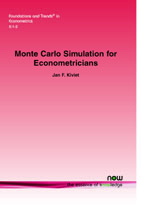Monte Carlo Simulation for Econometricians
By Jan F. Kiviet, Division of Economics, School of Humanities and Social Sciences, Nanyang Technological University and Department of Quantitative Economics, Amsterdam School of Economics, University of Amsterdam, The Netherlands, jfkiviet@ntu.edu.sg
Abstract
Many studies in econometric theory are supplemented by Monte Carlo simulation investigations. These illustrate the properties of alternative inference techniques when applied to samples drawn from mostly entirely synthetic data generating processes. They should provide information on how techniques, which may be sound asymptotically, perform in finite samples and then unveil the effects of model characteristics too complex to analyze analytically. Also the interpretation of applied studies should often benefit when supplemented by a dedicated simulation study, based on a design inspired by the postulated actual empirical data generating process, which would come close to bootstrapping. This review presents and illustrates the fundamentals of conceiving and executing such simulation studies, especially synthetic but also more dedicated, focussing on controlling their accuracy, increasing their efficiency, recognizing their limitations, presenting their results in a coherent and palatable way, and on the appropriate interpretation of their actual findings, especially when the simulation study is used to rank the qualities of alternative inference techniques.
Monte Carlo Simulation for Econometricians
Monte Carlo Simulation for Econometricians presents the fundamentals of Monte Carlo simulation (MCS), pointing to opportunities not often utilized in current practice, especially with regards to designing their general setup, controlling their accuracy, recognizing their shortcomings, and presenting their results in a coherent way.
The author explores the properties of classic econometric inference techniques by simulation. The first three chapters focus on the basic tools of MCS. After treating the basic tools of MCS, Chapter 4 examines the crucial elements of analyzing the properties of asymptotic test procedures by MCS. Chapter 5 examines more general aspects of MCS, such as its history, possibilities to increase its efficiency and effectiveness, and whether synthetic random exogenous variables should be kept fixed over all the experiments or be treated as genuinely random and thus redrawn every replication. The simulation techniques that we discuss in the first five chapters are often addressed as naive or classic Monte Carlo methods. However, simulation can also be used not just for assessing the qualities of inference techniques, but also directly for obtaining inference in practice from empirical data. Various advanced inference techniques have been developed which incorporate simulation techniques. An early example of this is Monte Carlo testing, which corresponds to the parametric bootstrap technique. Chapter 6 highlights such techniques and presents a few examples of (semi-)parametric bootstrap techniques. This chapter also demonstrates that the bootstrap is not an alternative to MCS but just another practical inference technique, which uses simulation to produce econometric inference. Each chapter includes exercises allowing the reader to immerse in performing and interpreting MCS studies. The material has been used extensively in courses for undergraduate and graduate students. The various chapters all contain illustrations which throw light on what uses can be made from MCS to discover the finite sample properties of a broad range of alternative econometric methods with a focus on the rather basic models and techniques.
